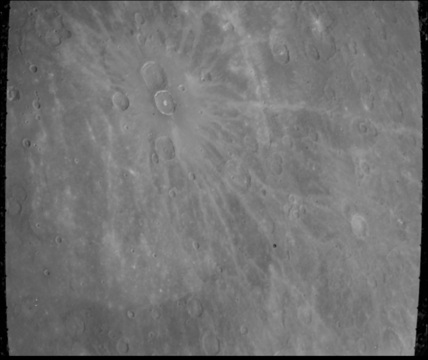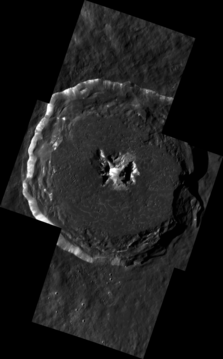 Degas crater,
MESSENGER spacecraft image, 2011. Inset is
Mariner 10 image from 1974. | |
| Planet | Mercury |
|---|---|
| Coordinates | 37°30′N 127°00′W / 37.5°N 127°W |
| Quadrangle | Shakespeare |
| Diameter | 54 km (34 mi) |
| Discoverer | Mariner 10 |
| Eponym | Edgar Degas |
Degas is a rayed crater on Mercury at latitude 37.5 N, longitude 127 W. Its diameter is 54 kilometres (34 mi). It was named after the French impressionist painter Edgar Degas in 1979. [1] The rays consist of light colored material blasted out during the crater's formation. Craters older than Degas are covered by the ray material, while younger craters are seen superimposed on the rays. [2] Degas forms a crater pair with Brontë to the north. Both lie near the center of Sobkou Planitia. [3]
The crater's floor contains cracks that formed as the pool of impact melt cooled and shrank. The high-reflectance material on the walls and in the central portion of the crater probably has a composition distinct from that of the crater floor and surroundings. The illumination conditions and down-slope movement of eroded material exposing fresh rock also contribute to the bright appearance. [4] The floor of Degas exposed low-reflectance material (LRM). [5]
Degas is one of the largest craters of the Kuiperian system on Mercury. The largest is Bartók crater. [6]
Views
-
Mariner 10 image
-
MESSENGER mosaic
-
Sequence of adjacent but non-overlapping images acquired by MESSENGER NAC of the interior of Degas. All images are oblique and looking northwest. The upper left three images show the central peak. The upper right and lower left images show the fractured crater floor. The two central bottom images show terraces and flow structures on the northern slope of the crater wall. The lower right image shows the crater rim. Distance across foreground in each image is approximately 2.5 km.
References
- ^ "Degas (crater)". Gazetteer of Planetary Nomenclature. USGS Astrogeology Research Program.
- ^ Nemiroff, R.; Bonnell, J., eds. (16 December 2000). "Degas Ray Crater on Mercury". Astronomy Picture of the Day. NASA.
- ^ Sobkou Planitia, at eSky
- ^ Degas Crater Archived 2014-09-14 at the Wayback Machine at NASA Messenger website. This article incorporates public domain text from this US government website.
- ^ Denevi, B. W., Ernst, C. M., Prockter, L. M., and Robinson, M. S., 2018. The Geologic History of Mercury. In Mercury: The View After MESSENGER edited by Sean C. Solomon, Larry R. Nittler, and Brian J. Anderson. Cambridge Planetary Science. Chapter 6.4.4.
- ^ Denevi, B. W., Ernst, C. M., Prockter, L. M., and Robinson, M. S., 2018. The Geologic History of Mercury. In Mercury: The View After MESSENGER edited by Sean C. Solomon, Larry R. Nittler, and Brian J. Anderson. Cambridge Planetary Science. Chapter 6, Table 6.4.
External links
-
 Media related to
Degas (crater) at Wikimedia Commons
Media related to
Degas (crater) at Wikimedia Commons


